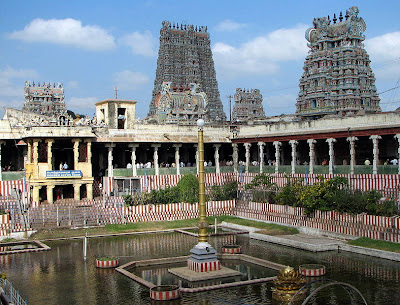Vaishno Devi Temple
Located 13 kms uphill from Katra, perched amidst the Trikuta Bhawati Hills at an elevation of 5300 feet above sea level is Mata Vaishnodevi Temple – a cave shrine dedicated to the Hindu Mythological Goddess ‘Shakti’ – the All-Supreme Goddess of creative power.
Most Hindu traditions believe that the Vaishnodevi Temple is the holiest of all the ‘Shaktipeeths’ – places of worship dedicated to Goddess Shakti. Vaishnodevi Temple is also the second most visited temple in India after the Tirumala Venkateshwara Temple in Andhra Pradesh.
Route of Vaishnodevi Yatra:
This 13-kilometre route between Katra and Bhawan is a steep hilly terrain with scenic splendours along the way.
1.Banganga: One kilometre from Katra, at a height of 2800 feet is Banganga – the first stop of the Yatra where pilgrims could take a holy-dip in the Banganga River. According to the Hindu mythology, Goddess Shakti shot an arrow into the ground at this site a spring of water gushed out which was later named the Banganga. ‘Prasad’ is offered here for free to all visitors which is hosted by the Indian Music House – T-Series. At this point the Yatra-passes / slips are checked by the security personnel in order to allow you to pass through.
2.Charanpadhuka: 2.5 kilometres from Banganga, at a height of 3380 feet is the second stop - Charanpadhuka Temple where Legend has it that Goddess Vaishno Devi halted to rest but as she was chased by Bhairav Nath, goddess Vaishno left the impressions of her feet on the rock while escaping from Bhairav Nath. This place houses the footprint of the Goddess and therefore the place got its name.
3.Adkuwari: 3 kilometres from Charanpadhuka, at a height of 4800 feet is the third stop - Adkuwari Temple – where the Goddess is said to have hid from the Bhairon Nath for months. Adkuwari is also known as Garbh Joon. This point is midway to the Vaishnodevi Temple. One can break the journey here and stay overnight here. At Adkuwari, you can have Darshan of Adkuwari Temple and Gerbhjoon - an ancient Cave of about 20 feet length.
4.Sanjichat: 4 kilometres steep climb from Adkuwari, at a height of 6200 feet is the fourth stop and the highest point of the Yatra. From this point one can have aerial views of Katra, Udhampur Reasi and Jammu.
5.Vaishno Devi Temple: 2.5 kms downhill from Sanjichat, at a height of 5300 feet is the final destination - Mata Vaishnodevi’s Cave Temple in Bhawan. It is said that Goddess Vaishnodevi revealed herself here in the form of three heads of natural rock (with a common base) called the ‘Holy Pindies’. The rock base is immersed in water. The ‘Darshan’ is that of the three heads. There are no other idols or pictures inside the temple that are worshipped. The cave is 30 meter long and just one and a half meter high so visitors would have to crawl their way into the cave temple. This temple is open round the clock and every single day of the year.
Goddess Vaishnodevi is said to be an incarnation of the combined supreme energies of Goddess Kali (force of dissolution), Goddess Lakshmi (force of prosperity and wealth), and Goddess Saraswati (supreme force of creation). About 2 kilometres from the Vaishnodevi Temple is Bhairon Nath’s temple where it is believed that Bhairon Nath was finally slain by Goddess Vaishnodevi.
The Temple Priests begin the Puja of Goddess Vaishnodevi in the wee hours before dawn when the Goddess is bathed in water, milk, ghee, honey and sugar and is dressed-up in a saree, chola, chuni and ornaments – all along chanting various ‘Shlokas’ and Mantras. Then the ‘Tilak’ is placed on the forehead of the deity and ‘Prasad’ is offered to her. A divine lamp – the Jyoti is lit and then the Aarti of the goddess is performed. The ‘Aarti’ of Goddess Vaishnodevi is performed twice a day at twilight – just before dawn and just after dusk. The Aarti is an elaborate Hindu ritual of worship where devotional ‘Aarti’ songs are sung while several lighted wicks are offered to the deity in a slow and graceful circulating manner. Once the Aarti inside the cave is done the Priests perform the same outside the cave at the entrance in the presence of the eagerly waiting pilgrims outside. After performing the ‘Puja’ and the ‘Aarti’, the Priests distribute ‘Prasad’ and the ‘Charanamrit’ (the holy water) to the devotees. The Priests take two hours to perform the ritual of ‘Aarti’ during which time the ‘Darshan’ of the Goddess Vaishnodevi is suspended. Interestingly, during this time when the cave temple is vacant, all maintenance work is done by the temple authorities as this is the only time they find the cave vacant in the whole day.
Recently, the Shrine Board has introduced 4 categories of individualized Pujas called the ‘Shradha Suman Vishesh Puja’ where the devotee is not worshipping the deity in a crowd but is made to perform the Puja individually with the help of the priests. These Pujas cost between Rs. 16,000 and Rs. 75,000 and entail Aarti Darshan, Prashad, accommodation in one of the Shrine Board accommodation units and meals during the stay.
For More details related to religious temples please log on to Hop Around India









